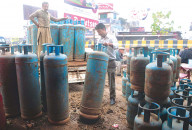Conflicting signals on actual growth rate
ADB report says economy to make slight recovery in FY2022-23

Finance Minister Miftah Ismail on Thursday told the federal cabinet that the economic growth rate during the current fiscal year will surpass the last year’s pace, according to a statement issued by the Prime Minister’s Office that shows a disconnect of the rulers with the fast unfolding harsh realities on the ground.
But hours after the issuance of the official handout by the PM’s Office, the finance minister appeared distancing himself from the statement. “Due to the prevailing economic conditions, the economic growth rate will slow down in the first half of the current fiscal year,” said Miftah Ismail while talking to The Express Tribune.
The minister added that once the external sector-related bottlenecks are removed, the economy may start picking pace during the second half (January-June 2023) of the fiscal year.
The finance minister informed the cabinet that during the current fiscal year the economic growth rate will be higher than the last fiscal year due to historical tax incentives given to the industrial and agriculture sectors, according to the press statement issued by the Prime Minister’s Office after the cabinet meeting.
The PM’s Office quoted Miftah as projecting higher than the last year’s growth rate a day after a senior official of the State Bank of Pakistan had said that against the 6% economic growth rate in the previous fiscal year, the economy is expected to slow down to 3% to 4% during the current fiscal year.
It was not clear whether the PM’s Office deliberately tried to give a positive spin to brief remarks by the finance minister in the cabinet or there was misunderstanding.
Prime Minister Shehbaz Sharif chaired the cabinet meeting on the day when the Asian Development Bank in its regional report projected moderate economic growth and high inflation in Pakistan and the region.
The IMF and the SBP have also said in recent days that Pakistan’s current economic crisis was rooted in the constant 6% growth rate during the past two years, which was not sustainable due to structural economic problems.
The finance minister’s statement suggests that the government is not fully realising the fast-changing economic realities that are pointing towards a dangerous situation developing around the country’s external sector.
Due to a gap between demand and supply of the US dollar, the rupee for the consecutive fourth day fell against the greenback and closed at Rs226.81 on Thursday. The rupee has lost 7.5% or Rs16 against the US dollar in just four days against already a very high base with no improvement in the conditions in sight.
The ADB on Thursday also released its Asian Development Outlook supplement report. The report stated that the GDP growth in Pakistan is expected to stay moderate in the fiscal year 2022 that ended on June 30 due to fiscal tightening measures with a view to manage growing demand pressures and contain external and fiscal imbalances.
The growth is projected to recover slightly in fiscal year 2022-23, supported by structural reforms, according to the lending agency.
It added that Pakistan’s inflation is substantially revised up for the current fiscal year but it did not give any figure. “In addition to the effects of elevated global energy and food prices, the government’s effort to revive the stalled IMF programme has meant raising power tariffs and withdrawing subsidies in the oil and power sectors,” according to the ADB.
The federal government has set the inflation target at 11.5%, but the SBP said that the inflation would remain in the range of 18% to 20%.
The ADB said that the headline inflation is at the double-digit levels in most of the Caucasus and Central Asia, Mongolia, East Asia, Pakistan and Sri Lanka in South Asia, and in the Lao People’s Democratic Republic and Myanmar in Southeast Asia.
Inflation in India, at 7%, and is above the 2%–6% target range of the Reserve Bank of India (RBI). But headline and core inflation in the rest of the developing Asia’s large economies remain manageable. So for the region as a whole, inflation remains moderate on average and much lower than elsewhere in the world.
The ADB revised the growth forecasts for developing Asia from 5.2% to 4.6% for 2022 and from 5.3% to 5.2% for 2023, reflecting worsened economic prospects because of Russia’s continued invasion of Ukraine, more aggressive monetary tightening in advanced economies, and COVID-19 lockdowns in the People’s Republic of China (PRC). South Asia’s growth forecast is lowered from 7% to 6.5% for 2022 and from 7.4% to 7.1% for 2023 mainly due to the economic crisis in Sri Lanka and high inflation and associated monetary tightening in India.
Developing Asia and the Pacific is continuing its recovery from the COVID-19 pandemic, according to ADB. Many countries are easing mobility restrictions, which is strengthening economic activity. However, growth has slowed in China, the region’s largest economy, due to disruption from new COVID-19 lockdowns, as well as weaker global demand.
“The economic impact of the pandemic has declined across most of Asia, but we’re far from a full and sustainable recovery,” said ADB Chief Economist Albert Park. “On top of the slowdown in China, fallout from the war in Ukraine has added to inflationary pressure that’s causing central banks around the world to raise interest rates, acting as a brake on growth, he added.
It’s crucial to address all these global uncertainties, which continue to pose risks to the region’s recovery, said the chief economist.
China’s economy is poised to expand 4% this year, compared with an earlier forecast of 5%. The ADB also lowered its growth outlook for India to 7.2% from 7.5% amid higher-than-expected inflation and monetary tightening.



















COMMENTS
Comments are moderated and generally will be posted if they are on-topic and not abusive.
For more information, please see our Comments FAQ